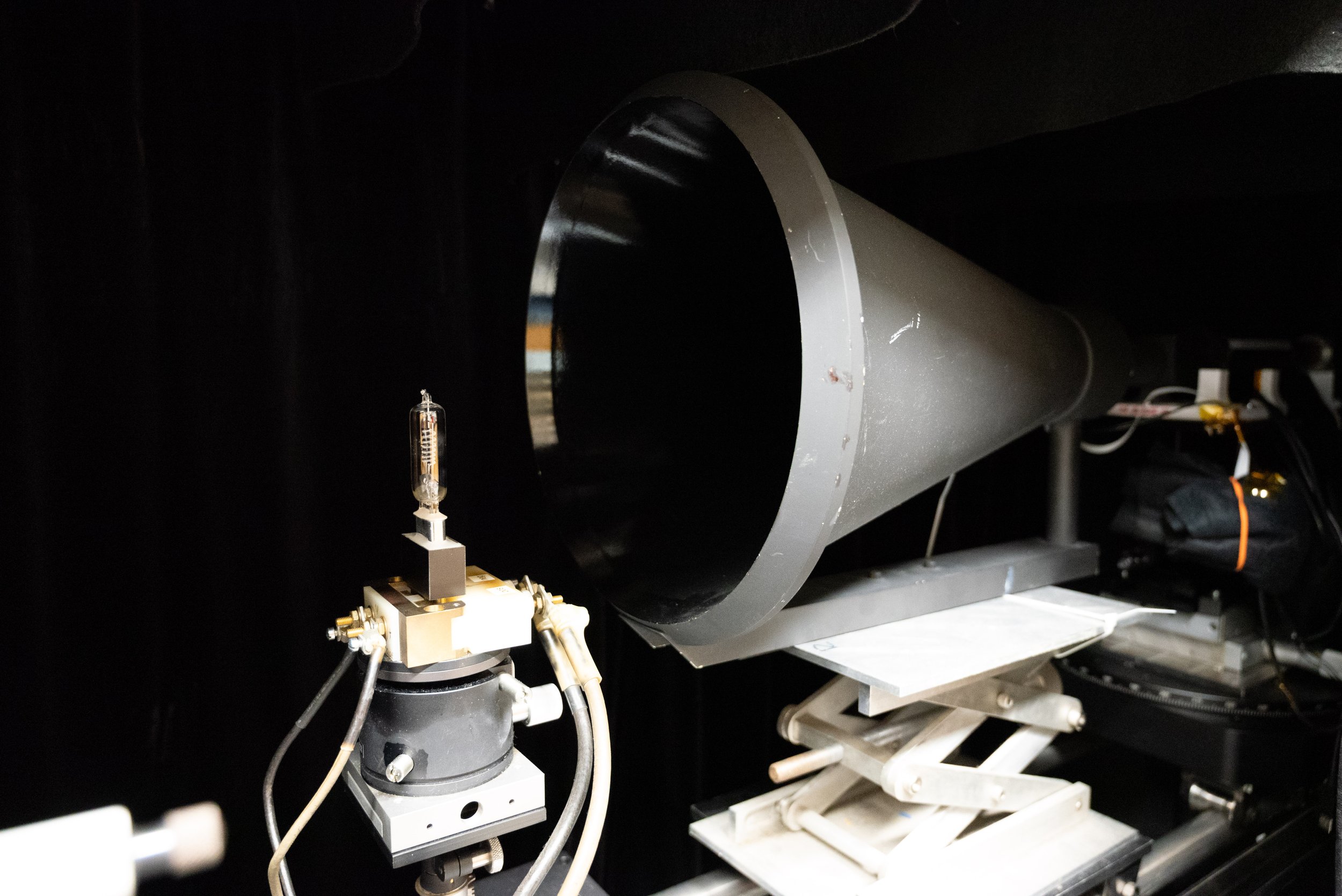Payload Calibration
AUTHOR: PROF. JUSTIN ALBERT
In order to use ORCASat to precisely calibrate telescopes when ORCASat is in orbit, we will need to know exactly how much light ORCASat emits, at any given time when a telescope observes it. Thus, the light output of ORCASat’s two laser diode light sources – as well as the onboard light monitoring, via ORCASat’s two onboard photodiodes – must be precisely calibrated! This laboratory optical calibration has now been performed at a national standards lab – specifically, at NRC’s spectroradiometric calibration facilities, located within NRC’s Montreal Rd. campus in Ottawa.
Together with NRC research officer Dr. Arnold Gaertner and NRC technical staff member Eric Cote, ORCASat team members Alex Doknjas and I performed two ORCASat laboratory calibration “campaigns” at the NRC spectroradiometry lab. The first, on May 9 – 13 of this year, was done right after the ORCASat vibration testing at the NRC Flight Research Lab (about 20 km away from the NRC spectroradiometry lab, on the other side of Ottawa). During this first “payload calibration campaign” at the NRC spectroradiometry lab, Alex found that one of the two payload photodiodes was not working, undoubtedly because of the hard vibration testing that had been performed just days previously. (Coincidentally, this was the case for both the ORCASat flight spacecraft and for the ORCASat functional prototype – in both cases, only one of the two onboard photodiodes was working during this first calibration campaign – although, as it turned out, the failure of the second photodiode to read out in both ORCASat spacecraft was for slightly different reasons.) Thus, this first calibration campaign ended up being much more of an opportunity just to create and test the alignment of the ORCASat calibration setup within the NRC spectroradiometry lab (which required the NRC machine shop fabrication of a couple of custom fixtures, in order to properly affix ORCASat onto the angular + x,y,z-translational stage in the NRC lab). This was absolutely critical in order to save time during setting up the second calibration campaign in late June however, though!




In order for Alex to figure out and then fix the problem with the second photodiode (on both the flight spacecraft and the prototype), the ORCASat spacecraft had to be back home in Victoria, though. So, during the period from May 15 – June 20, Alex, together with students Josh Fernandes and Ben Kellman, worked very hard to first determine, and then repair, the problems with the cable between 1) the photodiode front-end module that is directly attached to the ORCASat integrating sphere (on which just the photodiode and a temperature sensor are mounted), and 2) the photodiode readout board, which contains the precision amplifier and the digitization circuitry for the readout of both photodiodes. (Note that there are two such cables within each one of the ORCASat flight spacecraft payload and the ORCASat prototype spacecraft payload. In the case of both the flight spacecraft and the prototype, one of these two onboard cables was problematic [i.e., broken] following the vibration testing – however, the exact problems with those two cables happened to be slightly different [specifically, one had been due to a short, and the other had been due to a disconnection]. In both cases, though, just replacing the cable with a much-better-constructed cable was the solution! It was not easy, at all, for Alex to reach into the spacecrafts and replace these cables though! – but he did this very successfully!)




Following the above repair, Alex and I flew back to Ottawa with both the ORCASat flight spacecraft and the prototype on June 21, for the second payload calibration “campaign.” During this second campaign, which took place from June 22 – 24, the “real” ORCASat payload laboratory calibration work was done: all future combined calibration analysis of on-orbit data from ORCASat together with imaging data from telescope surveys such as LSST will always additionally require ORCASat laboratory calibration information from this NRC laboratory calibration campaign of the ORCASat payload. The calibration data that we obtained there at NRC will all be made public soon (i.e., before the deployment of ORCASat into orbit from the ISS!), and a hyperlink to all of this calibration data will be provided within this blog post. For now, suffice to say that this ORCASat NRC payload calibration data all looked quite excellent in our initial glances!
Immediately following this NRC payload calibration campaign in Ottawa – late on June 24, the ORCASat flight spacecraft and prototype, Alex, and I all drove off toward CSA HQ just outside Montreal for the ORCASat final integration into the Nanoracks cubesat deployer, and that is described in the next blog post.





Thank you very much to: NRC Research Officer Dr. Arnold Gaertner, NRC Technical Staff member Eric Cote, and NRC Photometric and Spectrophotometric Metrology Team Leader Dr. Li-Lin Tay for their fantastic help and work in making these ORCASat payload NRC laboratory calibration campaigns happen during these past couple of months! All future ORCASat scientific output will be entirely dependent on this outstanding pre-flight payload calibration work done at NRC!
